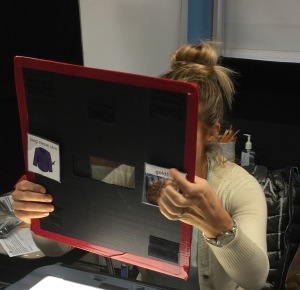There is great attention to the topic of CVI Meltdowns first introduced on CVI Scotland. Check out this wonderful link on the topic https://cviscotland.org/documents.php?did=1&sid=55
The CVI Meltdown is the reaction that some children with CVI have to the overwhelming visual or auditory situation and/or to the unfamiliar.
The CVI Meltdown needs to be seen not as a behavior but as an effort to try to communicate their anguish to adults. The behavior communicates “This is too much”, “I can’t do this anymore” or “I have had enough”. They are communicating their fear of not understanding where they are, not understanding who is with them and not understanding what is expected of them. This complex visual/auditory world is just plain beyond their capabilities and they want us to know.
Some children have learned that meltdown behaviors are not tolerated or that adults don’t react well to them. These clever children use other ways to escape.
Here are some examples:
Avoiders:
- Kevin and Henry close their eyes and appear to be sleeping. That solves the problem of visual complexity for them quite well. Adults think they are tired and let them rest.
- Susan focuses on her drawing or on her iPad and needs reminders to “pay attention”. Focusing on the familiar object and activity in her hands is accessible since the classroom learning is not. Adults want her to “pay attention”.
- Owen wants to go to the bathroom all the time. He is seeking that quieter, non-complex place to get away from overwhelming visual and auditory situations. He has learned that few adults will deny a child’s request for the bathroom. Adults take him to the doctor to see what is wrong with his urinary system. That checked, they see this as a behavior.
- Bella asks for a snack often. Snack is a familiar activity with more recognized materials. She has learned that few adults will deny her snack. If she keeps asking, the verbal engagement often gives her descriptions of what is going on around her.
- Jenny keeps her head down all the time. She has found this to be a way to avoid the complexity of the room. Adults are always telling her to “look up” but she always goes back to this head position in loud, busy and place with lots of movement.
- Barry wants to stand near corners or in the back of the room when things get overwhelming. He finds that he can avoid peripheral movement in these places and it is often quieter there. Adults think he should “join the group” more.
- Julie asks to go to the nurse multiple times a day. The nurse’s office is so quiet and calm. Adults first take her to the doctor and then see this as a behavior.
Distractors:
- Billy becomes the class clown. When someone enters the room, he can’t recognize their face. He greets new arrivals with “Here comes trouble” at which point, the person speaks to tell him to stop with the silly comments. Billy can’t stop because this is the only strategy that works for his lack of facial recognition. Adults see this as a behavior.
- Chad is a charmer. He wants to sing you a song or tell you a joke. He changes the interaction to an auditory event when the visual is too much or he is fatigued. Adults love a good joke and a good song.
- Perry talks too much. He asks lots of questions and is engaging adults in verbal interactions. He developed this nice strategy to get auditory information that he can’t get visually. Adults see this as a behavior.
- Gary’s mom describes him as “dramatic” in new situations. That drama is verbal and by engaging verbally, he can figure out what is going on. Adults deal with the drama that they see as a behavior.
What if people understood CVI? I believe if teams understood CVI, they would understand these behaviors as communication. They would know why these children were distracting and avoiding. I would love for staff and parents to listen with “CVI ears” to what their child is so clearly communicating.






